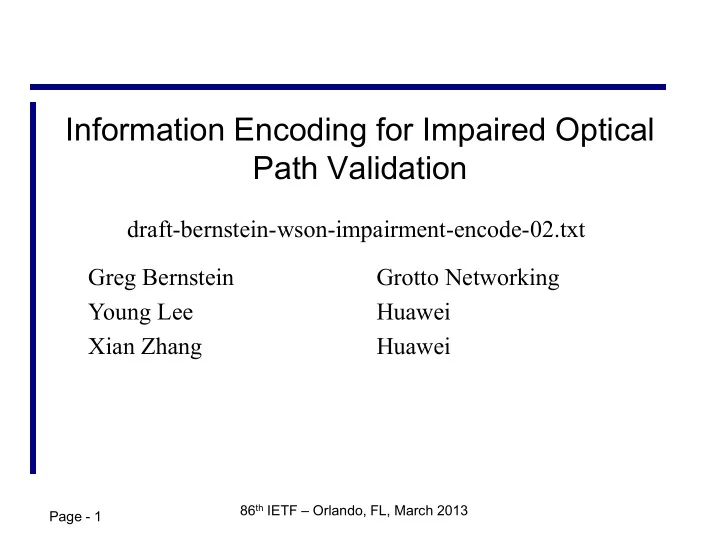

Information Encoding for Impaired Optical Path Validation draft-bernstein-wson-impairment-encode-02.txt Greg Bernstein Grotto Networking Young Lee Huawei Xian Zhang Huawei 86 th IETF – Orlando, FL, March 2013 Page - 1
Introduction • Works on the problem of efficient encoding of impairment parameters. • The definitions, characteristics and usage of the optical parameters that we encode are based on ITU-T recommendation G.680 and related. We do not define any new impairment parameters here. Units such as GHz, dBm, ps, etc… are taken directly from ITU-T recommendations. This is envisioned to be an area of frequent interaction. • This impairment encoding is intentionally similar with the impairment free model of reference [RWA-Info]. Page - 2
Parameter Classification and Encoding • NE Wide parameters – One per NE of each type • Port specific and Port-to-Port Parameters – Given N ingress and M egress ports we can have N+M instances of a port parameter and N*M instances of a port-to-port parameter. – Reality: many port parameters have similar values, same with port-to-port parameters. – Example [G.680]: in a simple ROADM insertion loss may be specified as “input to output”, “input to drop”, and “add to output” Page - 3
Port and Port-to-Port Encoding • Use Link set, and Connection matrix like structures from Routing and Wavelength Assignment Information Encoding for Wavelength Switched Optical Networks to indicate which ports or port pairs take the same parameter value. Existing connection matrix encoding can be extended for use in port-to-port parameter encoding 0 1 2 3 0 1 2 3 4 5 6 7 8 9 0 1 2 3 4 5 6 7 8 9 0 1 2 3 4 5 6 7 8 9 0 1 +-+-+-+-+-+-+-+-+-+-+-+-+-+-+-+-+-+-+-+-+-+-+-+-+-+-+-+-+-+-+-+-+ | Connectivity | Reserved | +-+-+-+-+-+-+-+-+-+-+-+-+-+-+-+-+-+-+-+-+-+-+-+-+-+-+-+-+-+-+-+-+ | Link Set A #1 | : : : +-+-+-+-+-+-+-+-+-+-+-+-+-+-+-+-+-+-+-+-+-+-+-+-+-+-+-+-+-+-+-+-+ | Link Set B #1 : : : : +-+-+-+-+-+-+-+-+-+-+-+-+-+-+-+-+-+-+-+-+-+-+-+-+-+-+-+-+-+-+-+-+ | Additional Link set pairs as needed | : to specify connectivity : +-+-+-+-+-+-+-+-+-+-+-+-+-+-+-+-+-+-+-+-+-+-+-+-+-+-+-+-+-+-+-+-+ Page - 4
Parameter Grouping • Bundle parameters that always appear together in the same TLV (sub-TLV, sub- sub- TLV, etc…) • Example (G.680): channel chromatic dispersion (in ps/nm) is usually specified by both a minimum and maximum value. Page - 5
Frequency Dependence of Parameters • Some impairment parameters may have a significant dependence on frequency over the wavelength of interest to the network. • A compact way to represent this dependence is via an interpolation function – General interpolation functions: piecewise constant, piecewise linear, cubic spline – Application specific interpolation functions: 3-term and 5-term Sellmeier formulas of Appendix A of reference [G.650.1] for fiber chromatic dispersion. Page - 6
Interpolation Encoding 0 1 2 3 0 1 2 3 4 5 6 7 8 9 0 1 2 3 4 5 6 7 8 9 0 1 2 3 4 5 6 7 8 9 0 1 +-+-+-+-+-+-+-+-+-+-+-+-+-+-+-+-+-+-+-+-+-+-+-+-+-+-+-+-+-+-+-+-+ | Interpolation| Num Ranges | Reserved | +-+-+-+-+-+-+-+-+-+-+-+-+-+-+-+-+-+-+-+-+-+-+-+-+-+-+-+-+-+-+-+-+ | Start Wavelength (first range) | +-+-+-+-+-+-+-+-+-+-+-+-+-+-+-+-+-+-+-+-+-+-+-+-+-+-+-+-+-+-+-+-+ : Range 1, sub-parameter 1 : + Interpolation type particular data + |-+-+-+-+-+-+-+-+-+-+-+-+-+-+-+-+-+-+-+-+-+-+-+-+-+-+-+-+-+-+-+-: : Interpolation data for : + other sub-parameters + |-+-+-+-+-+-+-+-+-+-+-+-+-+-+-+-+-+-+-+-+-+-+-+-+-+-+-+-+-+-+-+-: | Start Wavelength (next range) | +-+-+-+-+-+-+-+-+-+-+-+-+-+-+-+-+-+-+-+-+-+-+-+-+-+-+-+-+-+-+-+-+ : Range 2, sub-parameter 1 : + Interpolation type particular data + |-+-+-+-+-+-+-+-+-+-+-+-+-+-+-+-+-+-+-+-+-+-+-+-+-+-+-+-+-+-+-+-: : More ranges if needed : : : |-+-+-+-+-+-+-+-+-+-+-+-+-+-+-+-+-+-+-+-+-+-+-+-+-+-+-+-+-+-+-+-| | End Wavelength (for last range) | +-+-+-+-+-+-+-+-+-+-+-+-+-+-+-+-+-+-+-+-+-+-+-+-+-+-+-+-+-+-+-+-+ – Where “interpolation” specifies the type of interpolation to be use. Page - 7
Next Steps and Issues • Ideas and suggestions are invited. • Get input from Joint meeting with ITU-T SG15/Q6 for the directions. Page - 8
Recommend
More recommend